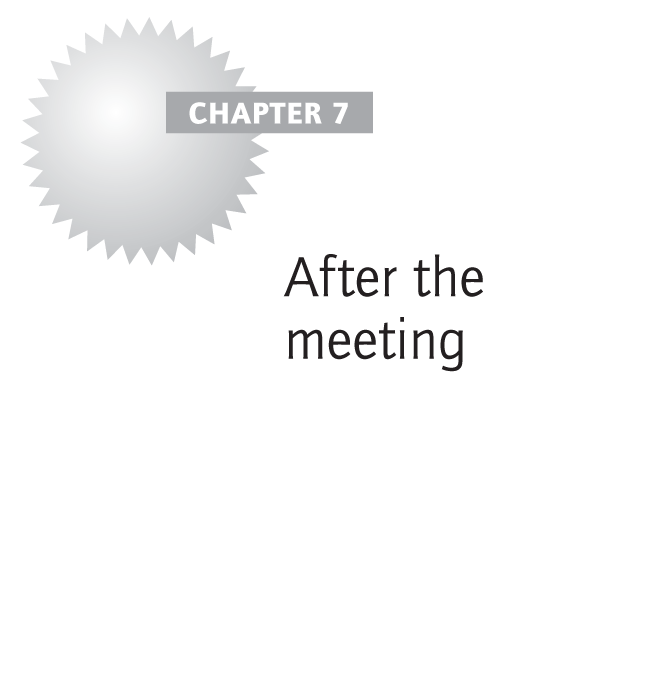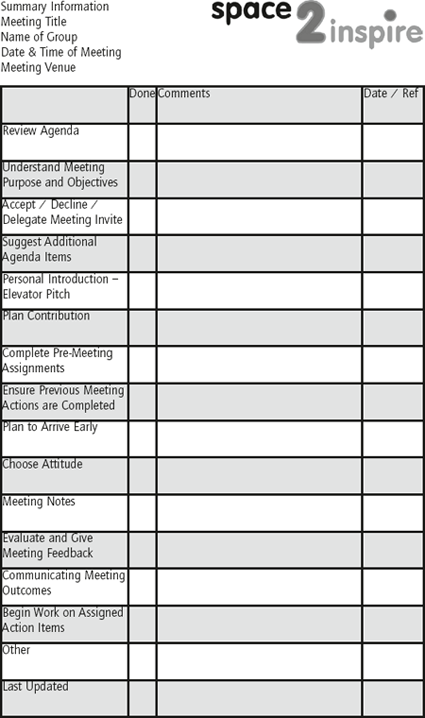Once the meeting is over, the actions and initiatives agreed upon by the participants can now begin; in effect, the ‘real work starts here’.
This assumes of course that you have not just experienced another of those ‘meetings about meetings’ where nothing advances. In fact, if this is the case, then the meeting should not have taken place at all.
Leaving the room
In a busy organisation, chances are that no sooner has your meeting finished then the next one in that room is going to begin. In larger organisations there may be someone assigned to clear everything away and set the room out for the next meeting. Nonetheless, it is no more than a common courtesy to remove from the table your own debris; the used glass or cup, any waste paper, etc. Are there any meeting notes still on a flip chart or dry erase board? Even if they are not confidential or would mean nothing to others, by leaving them visible you are inhibiting the immediate progress of that meeting. Remove the paper from the flip chart or turn it over to leave a clean page showing; erase the ink from the dry erase board. The simple rule is to leave the room in the exact state that you would have expected to find it at the start of your meeting. And if everyone does a little to help, it really will not take long.
Another common practice when the meeting has concluded is for participants to hang around in the room talking in pairs or small groups. Maybe it is last night’s football or legitimate business, either way we recognise that now the meeting has finished people are going to be departing in different directions, and so we take the opportunity to have these catch ups. Again, it is the next meeting you potentially are stopping from getting under way, so why not exit the room and find somewhere informal to continue those time outs?
Meeting actions
If this is a more formal type of meeting, you should receive the notes soon after the meeting has ended, which clearly set out individual actions, expectations and timescales. However, if you do not have this luxury, ensure that you have noted your personal actions clearly, and any other actions assigned to group members that could impact on the effectiveness and timescales of your results.
Notes will also refresh your memory regarding the presentations and discussions that took place, which can be essential if you have more than one meeting per business day.
The actions assigned to you are part of your job, so first assess how long each action will take you to complete. If the next action can be done in two minutes or less, do it when you first pick up the item.
Schedule the rest of your actions in to your calendar now so that you are regularly reminded. What will the impact be on others if you are late completing your actions? And by the same token what actions do group members need to complete before you can commence with yours? It is very easy to look at our work in isolation without realising the impact it has above, below and alongside us. If you have any doubts or concerns, then communicate this well in advance. If you have other work to do, then ask what will be the consequence of completing your task later than scheduled.

David Allen’s two-minute rule
If the next action can be done in two minutes or less, do it when you first pick up the item – even if that item is not a ‘high priority’ – because it takes longer to store and track any item than to deal with it the first time it is in your head. See www.gtdtimes.com.
To make sure that you will not need to read the information in Chapter 6, ‘Blagging it’, schedule the dates for the next meeting (if there is one) in to your calendar.
Communicating outcomes
If you are a designated representative for your colleagues or group, you need to be very clear about how you are going to share with them the outcomes from the meeting. Is it not human nature that we all assume that no news is bad news? So even if the news is not as positive as everyone is expecting, it is still better to share it with them and put a positive spin on it. Not communicating formally is how ‘Chinese Whispers’ start, and they are sure to spread more quickly in the absence of any formal information!
Depending on the number of people you need to communicate with and where they are located, will determine how you best share the news with them. An email is going to be the quickest way and, with today’s communication, it is likely that the message will be transmitted to their mobile phone screen even if they are not at their desks. However, if a very important message needs communicating, then a personal message delivered by you is best to alleviate any misinterpretations or concerns that may result from a quick email.
Can you group everyone together for a quick conference call? If people are in different time zones why not record them a personal audio (MP3) or video message they can play on their desktops or mobile devices as soon as they are back at work? This technology is readily available; it is inexpensive and will not overload IT networks, and it is what we have come to expect in the You Tube™ generation.



